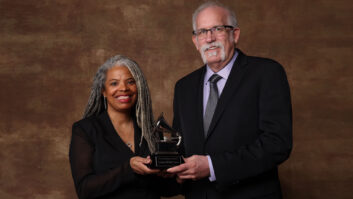
Los Angeles, CA—The Grammy Awards show, regularly held at the Staples Center in downtown Los Angeles, has long employed a large splitter system to distribute microphone and instrument signals from the multiple stages to the house sound and broadcast audio mixing consoles. This year, the production began a transition to audio-over-IP networking, deploying a Dante transport enabled by a variety of Focusrite RedNet audio and format converters for the show’s performance and production wireless microphones.
AoIP networks have become relatively commonplace for touring productions, but the Grammy Awards show is several orders of magnitude more complex than a plug-and-play touring rig. For starters, signals need to be distributed over fiber to three different brands of mixing consoles at four separate locations: four DiGiCo desks (two at FOH, two at monitors), two Lawo consoles in the Music Mix Mobile M3 broadcast trucks, and a Calrec mixer in the NEP Denali broadcast production truck.
As the first phase of a planned multiyear AoIP adoption, this year’s Grammy Awards telecast involved distributing signals from the Sennheiser Digital 6000 and Shure Axient wireless mic systems used on stage via eight Focusrite RedNet D64R Dante-to-MADI bridge units, providing a primary and redundant stream to each of those four mix locations. Signals from analog and non-network-enabled RF mic systems passed via Focusrite RedNet MP8R mic preamp or D16R bridge units.
An Optocore DD4 provided the MADI interface to the DiGiCo FOH and monitor network, while Calrec’s Hydra MADI units fed signals to the Denali truck. Lawo MADI units directed the RF mic channels to the two M3 trucks.
Jeff Peterson, P.A. designer at ATK Audiotek, which has long provided in-house sound for the show, oversaw the preliminary off-site Dante network build out and configuration.
“Because the connectivity is so massive, you couldn’t do it in the two days—16 hours—we have,” says Michael Abbott, who has been the show’s audio coordinator for more than 30 years. “It would require more manpower and more time to manage on site, and none of this happens without a cost factor.” But for the show, says Abbott, “I insisted that we have a dedicated network engineer/manager,” to manage any on-site issues.
The new distribution scheme was a lot more work to implement, he says. “But the best plus-factor is the quality of the audio that we’re able to reproduce. We knew we were going to get a better frequency response without all the splitting going on—the payoff was that it was substantially noticeable.”
Another show veteran, Ron Reaves, who handles the house music mix, says that he immediately heard an improvement in the wireless mic audio. “The mics sounded better right out of the gate, so I had to do a lot less EQing,” he reports. Indeed, the new distribution network significantly opened up the top end of the mics, Reaves says, “to the point where there were a couple of performances on the satellite stage near our position where I had to apply a low-pass filter and take a little top end off, because they were in front of the P.A.”
Winners in the Production Categories at the 2020 Grammy Awards, by Steve Harvey, Jan 27, 2020

It was Eric Schilling, one of two mixers in the Music Mix Mobile M3 trucks, who first recommended adopting an AoIP network. “I had done a show a couple of years ago like that, so I talked to Mike [Abbott] for a couple of years about doing this,” he says. “It took us a while to get a game plan because we have a lot of people involved and a lot of mix positions in the show.”
Schilling says that eliminating the splitter system’s signal degradation from the RF mic paths cleaned up the audio. “The performance mics sounded a lot clearer to me because they weren’t going through a splitter. I found myself doing less processing on the vocals in terms of both low end and high end. I didn’t feel like I had to ‘carve out’ as much as I do on a typical mic through a splitter, where it might be a little murky in the low end.”

Ranky Tanky: Gullah, Good Time and a Grammy Win, by Steve Harvey, Jan. 28, 2020
Since system redundancy is a tenet of the Grammy Awards’ broadcast audio production, the analog distribution path of previous years was retained, along with a global spares path should any microphones fail. That allowed the mixers to flip between analog or Dante sources.
“The analog side was via the new DiGiCo preamps, so I had the best of both worlds,” says Reaves. “Even the analog path sounded pretty sparkly.”
Abbott began planning for this initial Dante rollout about eight months ahead of “Music’s Biggest Night,” collaborating with the show’s engineers, the vendors—ATK, NEP Denali and Dante developer Audinate—and the Grammy Awards production company. Budgets permitting, the next phase, set for 2021’s show, will be connectivity of the back-of-house audio paths—some 250-plus channels—via an AoIP network. The third phase would see all of the stage instrument channels integrated onto the network.

The use of Dante-MADI bridges will likely need to transition to a Dante-only infrastructure to accommodate higher channel counts, says Abbott. This is due to CBS’ plans to transmit an immersive mix over its broadcast network and CBS All Access streaming service in the not-too-distant future, he says. “We want to be prepared to provide the infrastructure for the high channel count that will be required for immersive audio,” he says.
The Grammy audio team has been recording six overhead microphones located 75 feet above the arena floor plus the 16 audience reaction mics in the arena’s lower bowl, together with the broadcast production and music tracks, for subsequent proof-of-concept mixes. Those tracks totaled about 570 channels this year, says Abbott.
“That’s more than one Dante network. But once we start getting into stems for immersive, we’re probably talking from 32 to 64 channels at each of those three mix positions. Moving forward with some type of immersive assets, we will be scaling into providing 800-plus channels,” he predicts.
As Abbott lays out the roadmap for the three-year AoIP network implementation, it remains to be seen what the future holds for today’s transport protocols. “My fear, as we move forward in the next three years, is where we will be with the adoption of SMPTE ST 2110 or AES67/AES70 into our workflow. Is the hardware infrastructure and technology going to be obsolete or dated?”
One thing is certain, he says: “The challenges are always there for us.”
Audinate • www.audinate.com
Focusrite • pro.focusrite.com







